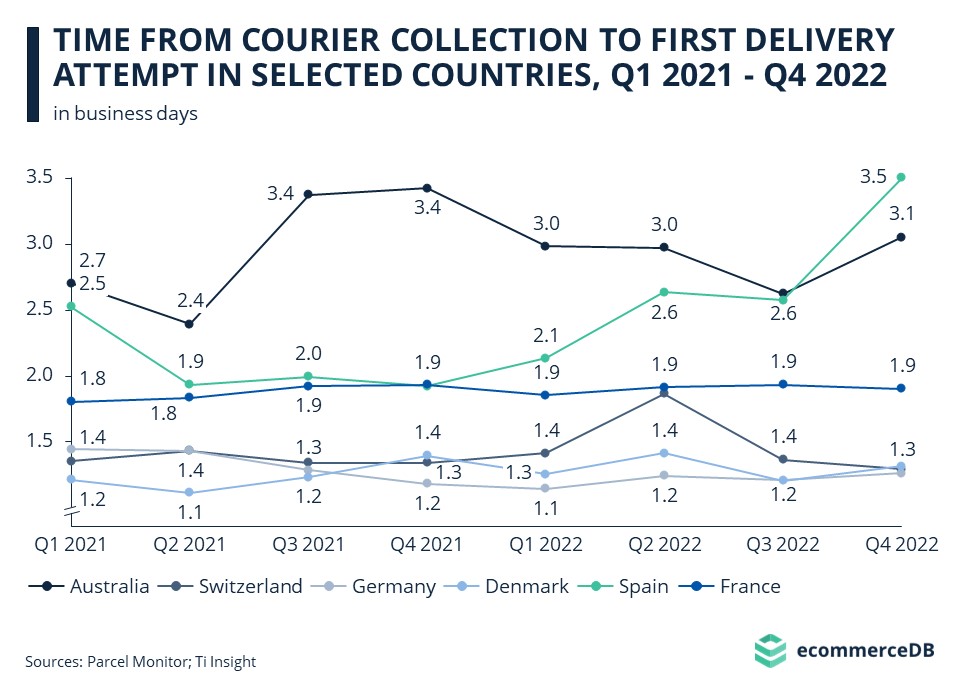Parcel delivery times are most stable in France
May 03, 2023
The popularity of eCommerce poses ongoing challenges to global logistics. Especially the highly Covid-influenced years 2020 and 2021 saw unprecedented parcel volumes – as many as 159 million packages were shipped worldwide in 2021. Although the online shopping boom of the lockdown years levelled off remarkably in 2022, resulting even in a drop in global order volumes and market revenues, parcel deliverers are still busy processing the orders of a currently US$3.5-trillion-heavy global eCommerce market (Digital Market Outlook). At the same time, consumers are ever more demanding as far as delivery features are concerned. Next to free (return) shipping and shipment tracking, fast delivery is among the top 3 most important delivery criteria for online shoppers in the U.S., Germany, and the UK, according to the Statista Global Consumer Survey eCommerce Special. Can deliverers keep up with such high demands? Ti Insights and Parcel Monitor give hints:

In times when consumers place great importance on fast delivery of their online orders, parcel transit times – i.e. the time a parcel stays with the deliverer from pick-up to the first delivery attempt – are a decisive factor in customer satisfaction. Parcel Monitor data shows that parcel transit times vary remarkably between countries. Out of the six countries analyzed, parcel transit times are highest in Australia, with between 2.4 and 3.4 days on average over the examined period. These comparably long delivery times can probably be attributed to the much greater distances on the Australian continent in comparison to the other countries. With an average of 1.8 or 1.9 days over the quarters between Q1 2021 and Q4 2022, France is in midfield in terms of total transit time, but it is the country with the most stable and thus most reliable delivery times in this comparison. Although deliverers in Germany, Denmark, and Switzerland are most of the time faster, their transit times were more volatile over time – the three countries take turns as the country with the fastest transit time in this comparison. Four out of six countries analyzed showed a remarkable increase in transit times in the fourth quarters – when holiday shopping boosts order volumes. Spain saw an especially pronounced increase in the course of 2022, almost doubling its average parcel delivery time between Q4 2021 and Q4 2022. On average, deliverers needed 3.5 business days between pick-up and first delivery attempt in Spain in Q4 2022 – which was even longer than in Australia. According to the source, labor shortages might be a reason for increased transit times.
Related insights
Article
Shein and Temu Products Clog Air Transports
Shein and Temu Products Clog Air Transports
Article
Global eCommerce Logistics: Market Size, Regional Trends, Growth Factors
Global eCommerce Logistics: Market Size, Regional Trends, Growth Factors
Article
Cart Abandonment Rate in Europe: Country Statistics, Shipping & Consumer Behavior
Cart Abandonment Rate in Europe: Country Statistics, Shipping & Consumer Behavior
Article
Innovative Delivery Options in Germany in 2023: Consumer Behavior by Generation and Gender
Innovative Delivery Options in Germany in 2023: Consumer Behavior by Generation and Gender
Article
eCommerce Logistics: What Is It & How Does It Work
eCommerce Logistics: What Is It & How Does It Work
Back to main topics